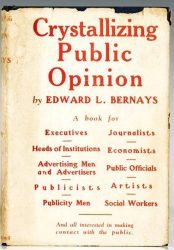
One hundred years ago, Edward Bernays, the father of public relations, dedicated the fifth chapter in his book, “Crystallizing Public Opinion” to show how public relations and human behavior are codependent. Today, the cognitive revolution is still alive and well, and in fact, is more influential than ever. Looking at recent examples in the news, like George Floyd’s murder in the U.S., the 2020 Trump-Biden presidential election, The Great Resignation, and the COVID-19 pandemic, the cognitive processes of perception, memory, and encoding are how humans make the most important life decisions. For example, from whom to vote for or whether to vaccinate (or not), every decision made by a human being is based on conscious beliefs, values, and convictions. In other words, our body’s “computer” (aka our brain) processes information in a way that makes sense to us – based on these beliefs, values, and convictions – and the output is a decision (Psychology Today, n.d).
In Chapter V, Bernays works through neurosurgeon and behavioral scientist Wilfred Trotter’s five characteristics detailing how popular components of behaviorism influence public relations techniques (Bernays, 1923). Here, I examine how the five characteristics have changed (or stayed the same) over the past 100 years and how the cognitive revolution has changed the way we practice public relations.
- “He is intolerant and fearful of solitude, physical, or mental”
In Bernays’ day, living or thinking in solitude was not the norm. Embarking on a career one did not particularly like for the sake of a family was typical. Today, individual thought and action is much more valued. Born between 1997 and 2012, Gen Z are the first generation to be fully immersed in the internet, are politically savvy, activism oriented, question everything, and have no problem evoking cancel culture on any brand that goes against their morals (Debczak, 2023). To influence individual thought, PR practitioners need to have their eyes and ears on social media, prioritize sentiment over facts, and sometimes adhere to the wisdom of the crowd over the conversations in the boardroom.
Social media makes it hard for people to be alone as algorithms track our online behavioral patterns and suggest who we should engage with, what we should buy, and what activities would make us happy. While communications professionals live and die by these metrics to do their jobs well, it does enable tribe behavior. This behavior only perpetuates an “us vs. them” mentality and further fractures marketing dollars to reach specific cohorts.
- “He is more sensitive to the voice of the herd than to any other influence.”
While a focus on individualism is on the rise, PR practitioners still heavily rely on the circle of influence to impact individual decisions. In fact, humans tend to seek out information that confirms what they already believe and avoid contradictory information. Defined as confirmation bias, this powerful behavioral theory can also be dangerous (Cornell Law School, 2022). Today’s practitioners still have the opportunity to leverage known confirmation biases of their key publics for campaign success.
- “He is subject to the passions of the pack in his mob violence and the passions of the herd in his panics.”
Leaders take on the burdens of their employees, understand root causes of problems, and actively work to fix them so the job gets done well (O’Grady, 2022). Ideally, they are also independent thinkers who do what is best for the whole, and avoid taking action that only benefits or protects themselves. Today’s leaders need to avoid acting because of external pressure and instead, let PR ethics be their guide. This is easier said than done, especially with a 24-hour news cycle and social media. Corporate leaders are pressured to comment on issues affecting their key stakeholders, but more often than not, this pressure yields to silence out of the fear of backlash or, worse, legal ramifications. This juxtaposition makes the PR practitioner’s role even more important, as they need to help navigate C-suite conversations to address what keeps their publics up at night, while maintaining positive sentiment.
- “He is remarkably susceptible to leadership.”
Typically, humans innately default to the opinions and expertise of authority figures. While the cognitive revolution may have altered unconditional trust in these figures, we still see this tactic used frequently today. From 9-in-10 dentists recommending a particular toothpaste to a president encouraging us to vote, we are susceptible to the influence of prominent people and authority figures.
Influence, however, is not limited to those with actual authority. Today, people in the entertainment industry, fitness instructors, and YouTubers are just a few other cohorts of humans that everyday consumers aspire to be (Jankowski, 2021). The problem, however, is that consumers misperceive celebrities and social media influencers for experts. While achieving client goals is important, communications professionals should always keep ethics top of mind and not capitalize on consumer insecurities to promote products and services.
- “His relations with his fellows are dependent upon the recognition of him as a member of the herd.”
By definition, herding (or a group defined as a herd) happens when individuals follow others and imitate the behaviors of a group rather than thinking and acting independently (Baddeley, 2010). While the cognitive revolution leans into individual thought, the fear of being alone, not being part of a group, and/or being “canceled” remain drivers of behavior. In Bernays’ day, spokespeople were chosen based on this principle, and it’s no different in 2023. If the leader of an organization makes a misstep, good PR people coach them in how to appeal to emotion as well as logic. Believability is correlated to how relatable one is to those they want to influence.
It’s an understatement to say the world has changed since the 1923 publication date of “Crystallizing Public Opinion.” This includes how PR practitioners approach their work. While modern inventions like the internet and social media have changed the functionality of the work, how humans process information has changed the approach. While the five characteristics discussed in Chapter V are still fundamentally sound, the cognitive revolution yielded the consumer as a smarter and more perceptive being. Today, we – as practitioners – can leverage the advancements of behavioral science to do our jobs better: With more honesty, authenticity, and transparency.
References
- Baddeley M. H. (2010). Social influence and economic decision-making: socio-psychological and neuroscientific analyses. Philos Trans R Soc Lond B Biol Sci. 365(1538):281-90. doi: 10.1098/rstb.2009.0169. PMID: 20026466; PMCID: PMC2827453.
- Bernays, E. (1923). Crystalizing public opinion. New York: Boni and Liveright.
- Cornell Law School (2022). Confirmation bias. https://www.law.cornell.edu/wex/confirmation_bias.
- Debczak, M. (2023, Feb. 3). These revised guidelines redefine birth years and classifications for millennials, gen z, and gen alpha. Mental Floss. https://www.mentalfloss.com/article/609811/age-ranges-millennials-and-generation-z#:~:text=Millennials%3A%20Born%201981%2D1996%20(,0%2Dabout%2010%20years%20old).
- Jankowski, P. (2021, March 5). Not all influencers are celebrities…not all celebrities are influencers , part 2. Forbes. https://www.forbes.com/sites/pauljankowski/2021/03/05/not-all-influencers-are-celebritiesnot-all-celebrities-are-influencers-part-2/?sh=64f185161f35.
- O’Grady, K. (2022). The Great Resignation: How to Retain Your Best Employees. Institute for Public Relations. https://www.youtube.com/watch?v=-N7xifzHAoo.
- Psychology Today (n.d.) Cognition. https://www.psychologytoday.com/us/basics/cognition.

Dr. Kerry O’Grady is a faculty affairs expert, award-winning curriculum developer, higher education consultant, and seasoned public relations practitioner.



